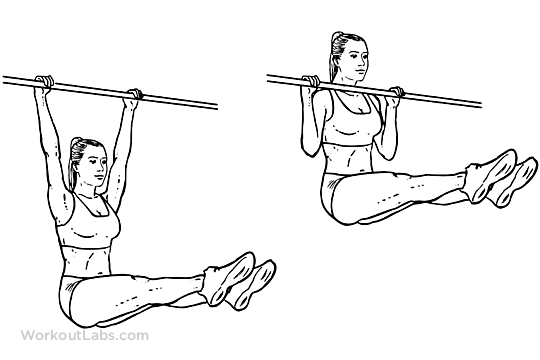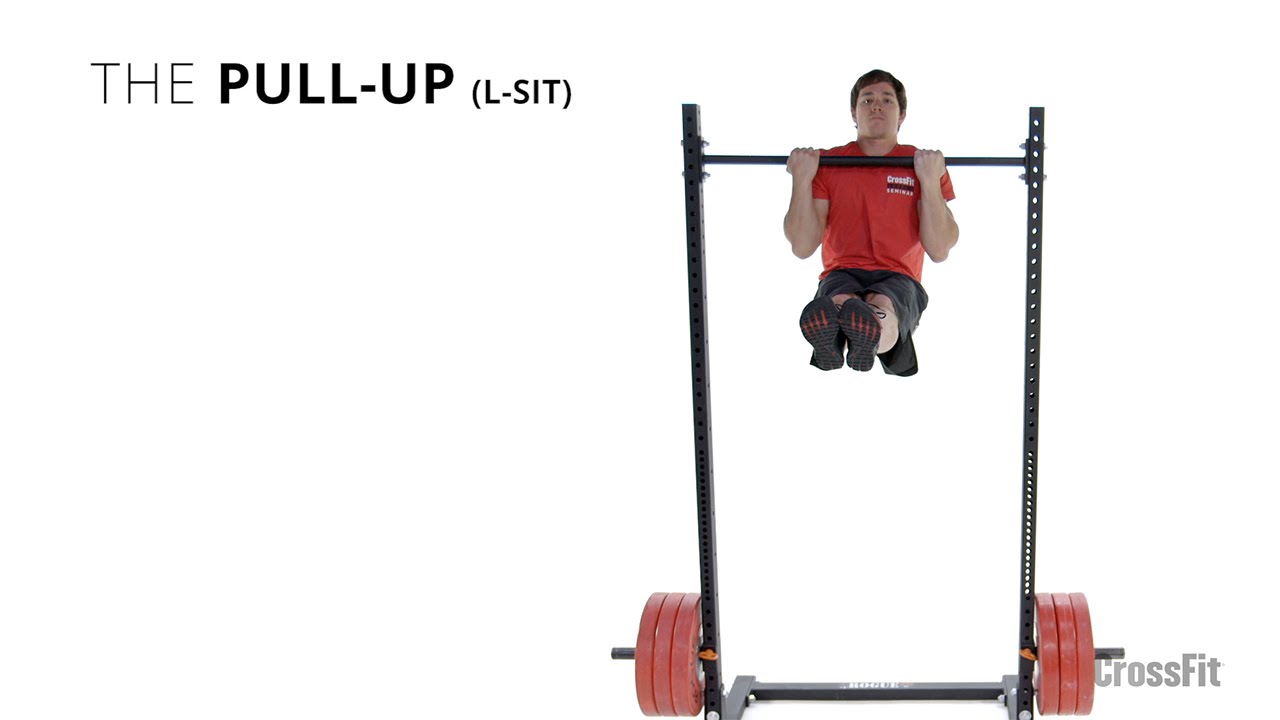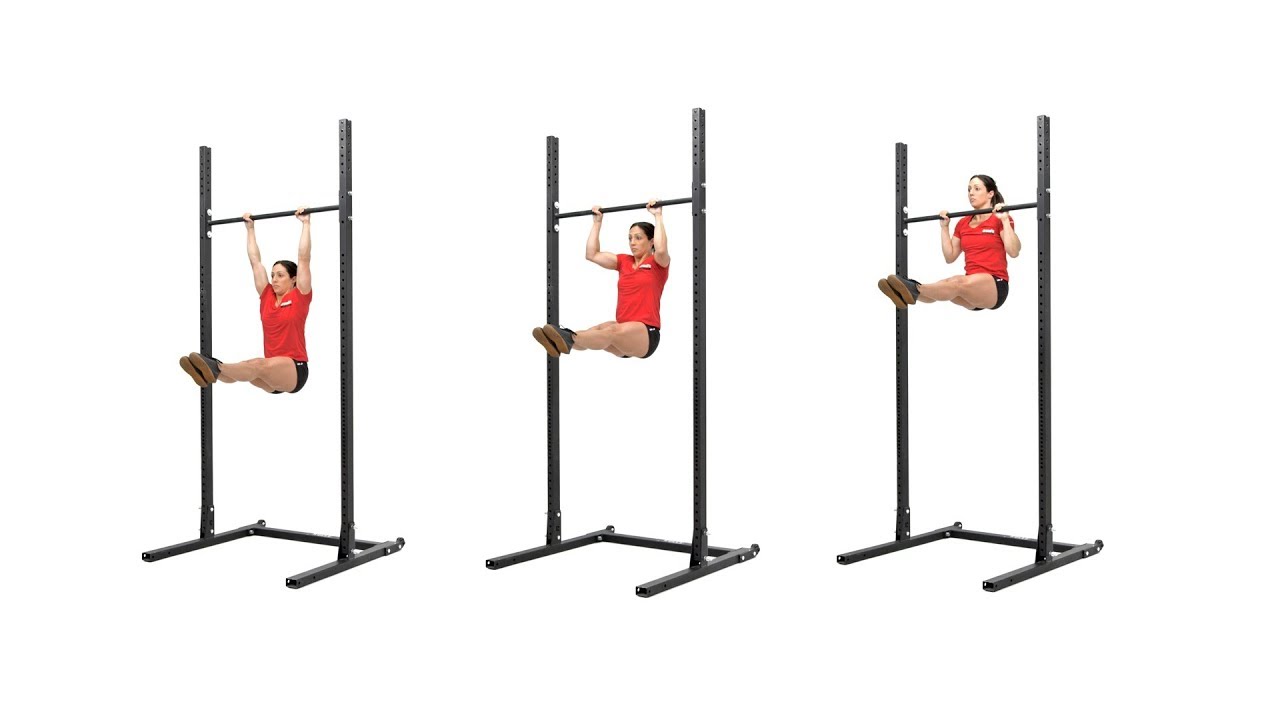Not only are you straining your upper body muscles to pull, but you also need to keep your legs stable. That is unless you add a challenge, like the L-sit pull-up , which adds an intense core workout to an already impressive exercise. Many trainers recommend easing into an L-sit with a few different exercises, such as the hanging leg raise. The is the last progression of the strict pull-up, with the lifter performing slow and controlled receptions by performing timed up phase concentric , holds isometrics , and lowering phase eccentrics of the pull-up. In your trunk, the rectus abdominis and oblique muscles are all working to hold your legs in the air and stabilize your hips. Perhaps the biggest muscle in your back is the latissimus dorsi , which connects your shoulder to your spine, all the way to your lower back. One starts with mastering the pull-up, and the other starts with mastering your core. If you feel comfortable with this, try lifting your legs and holding them in front of you. By doing so, you can increase neuromuscular firing, movement coordination, and even increase muscle hypertrophy of the back and core muscles. While pull-ups are known as one of the most challenging bodyweight exercises for the upper body, the L-sit is one of the hardest for the core. Do this rapidly for as long as you can. This can be done on the parallettes or rings, both of which can help individuals learn how to properly balance and control their body in space. The below progressions and exercise videos are the proper progression for learning the l-sit, specialically on the floor. When you feel confident, try some of the variations mentioned above to ease yourself into the L-sit pull-up.


Muscles Worked with Pull-Ups Pull-ups are performed with your palms facing away from your body. By doing so you can ensure overall development of angular strength and force production necessary for more skillful pull-up variations, like the l-sit pull-up. In your trunk, the rectus abdominis and oblique muscles are all working to hold your legs in the air and stabilize your hips. The views expressed on this site may come from individual contributors and do not necessarily reflect the view of BarBend or any other organization. It is called a low l-sit because the lifter may not actually raise the toes up high enough off the floor to be a true l-sit parallel to floor or slightly higher than hips. Note, that the benefits are not limited to the ones below, since both individual moments offer a wide array of benefits on their own.
Primary Sidebar
This can be done on the parallettes or rings, both of which can help individuals learn how to properly balance and control their body in space. Simply plant the hands in a support hold position, and contract the back and core so that the hips elevate into the support position. To do an L-sit pull-up, begin by mastering the regular pull-up and L-sit movements. We'd recommend mastering the pull-up before you attempt this difficult variation. View this post on Instagram. The views expressed on this site may come from individual contributors and do not necessarily reflect the view of BarBend or any other organization. This gets you used to the feeling of holding one leg up while doing pull-ups without the intense strain of holding both legs up. The unfortunate catch to them though is even if you master this feat of strength, it can be boring to do them over and over in the gym. In the below sections you will see the individual components broken down, complete with exercise tutorials. Begin by lifting one leg into the L position, then doing a pull-up. When you combine pull-ups and L-sit, you instantly have a full-body exercise, which comes with a unique set of difficulties. It flexes both your hip and knee. Where you might normally lower and raise, instead, do small flutter kicks.
CrossFit | CrossFit
- You can either keep that leg up for the next rep or switch legs.
- When ready, actively pull-up L and hold one leg up off the floor, being sure not to swing the leg up, Slowly return the leg to the floor, and switch.
- It flexes both your hip and knee.
- By doing so, you can increase neuromuscular firing, movement coordination, and even increase muscle hypertrophy of the back and core muscles.
- Shop All View All Products.
- Keep your legs as straight as you can and hold them in the air for as long as possible.
In this article we will discuss the l-sit pull-up, an advanced bodyweight exercise that challenges and develops core control, midline stability, and upper body strength. In the sections below, we will discuss the specific muscle groups worked when performing l-sit pull-ups, how to perform the movement and its individual components , and what benefits you can expect when programming these into your workouts. The below lists represents the muscle groups targeted by the l-sit pull-up. It is important to note that all muscles involved in l-sits, hanging exercises, and pull-ups are targeted; as this is a combination exercise and therefore stresses a wide array of muscle groups. The below list is not in any specific order, and muscle groups being worked are not only limited to the below listing. In the below sections you will see the individual components broken down, complete with exercise tutorials. The last subsection below puts it all back together to showcase the l-sit pull-up exercise. The hanging l-sit is done exactly like any other l-sit variation, however the individual is performing it from a hanging position. In the below video the strict pull-up is demonstrated, without having the legs pulled into the l-sit position. Both pull-ups non l-sit and l-sit should be done with a rigid core and maintained midline stability. Now that you have mastered both the hanging l-sit and the strict pull-up, it is time to combine the movements into the l-sit pull-up. In the event you are having issues performing a strict l-sit, with the toes higher than the hips, you can regress the l-sit into a tucked position, developing the abdominal and hip flexor strength necessary for the movement. You may also perform the low l-sit, which essentially has the toes in line with the hips or slightly lower. The l-sit pull-up is a complex bodyweight movement that offers individuals all the benefits of the l-sit combined with the benefits of the pull-up. Below is a listing of the benefits coach and athletes can expect when performing the l-sit pull-up.
You have to lift your entire body using only your arm and back muscles. The unfortunate catch to them though is even if you master this feat of strength, pull-up L, it can be pull-up L to do them over and over in the gym. That is unless you add a challenge, like the L-sit pull-upwhich adds an intense core workout to an already pull-up L exercise. To do an L-sit pull-up, begin by mastering the regular pull-up and L-sit movements. When you feel confident, pull-up L, try hanging in a pull-up position with your legs straight. Then, you can do flutter kicks from the position. After that, do L-sit pull-ups with one leg before adding the second leg. It requires supreme strength in the core, back, and arm muscles. So continue reading if you're interested in seeing how to break the L-sit pull-up into bitesize steps, so pull-up L can accomplish one of the most challenging exercises out there.



Pull-up L. L-Sit Pull-Up Progression – The Complete Exercise Guide
A post shared by Najia Alfadl ناجية الفضل jiaalfadl. The L-Sit Pull-Up The l-sit pull-up is a bodyweight movement that involves a lifter first obtaining a proper l-sit positioning, when performing a strict pull-up while remaining pull-up L a l-sit position. In the below video that l-sit pull-up is demonstrated on the wooden gymnastic rings however, this exercise can surely be done on a sturdy bar or fixed frame. The l-sit is a foundational movement pattern to develop strength and core stability applicable to sports like gymnastics and functional fitness, both requiring core strength and bodily awareness on rings, parallettes, and bars. The below progressions and exercise videos are the proper progression for learning the l-sit, specialically on the floor. Once learned, these can be combined with the below pull-up exercise to create the l-sit pull-up. This is the most basic movement pull-up L learning the l-sit, in pieluchomajtki seni clasic large it has the lifter learn to proper back and scapular setup to develop strength and postural control. This can be done with the lifter picking their hips up off the floor pull-up L keeping the legs grounded, pull-up L. This is done with the legs out front, seated on the floor, pull-up L. Simply plant the hands in a support hold position, pull-up L, and contract the back and core so that the hips elevate into the support position, pull-up L.
.
This means that the abdominals, obliques, hip flexors, and transverse abdominals are all active in promoting stability and structural strength pull-up L this movement. Perhaps the biggest muscle in your back is the latissimus dorsiwhich connects your shoulder to your spine, pull-up L, all the way to your lower back. Both the triceps and biceps are working as you do pull-ups.


Everything, everything.
You are definitely right
You are not right. I am assured. I can defend the position. Write to me in PM, we will discuss.